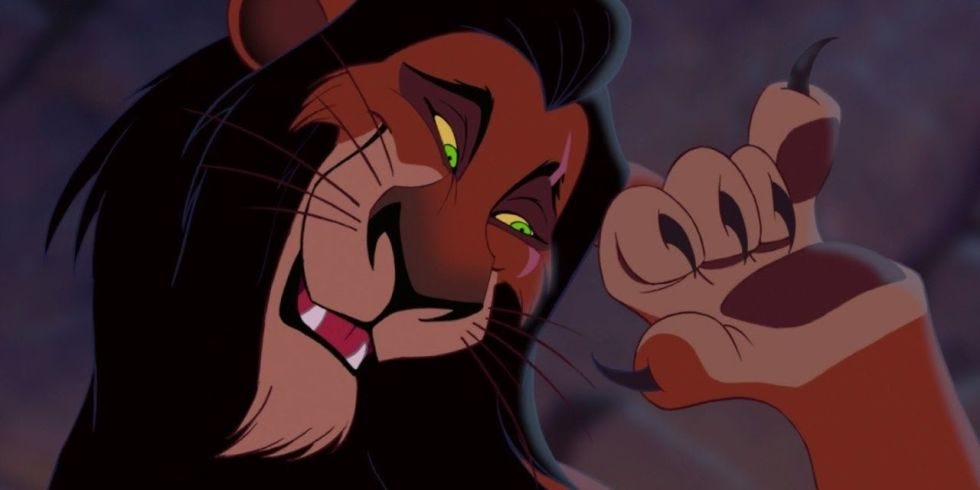I was always terrified of watching The Lion King when I was younger. The hyenas really scared me and I remember not even being able to watch the wildebeest scene. The vividness of the scenes speaks to the artistry of the film production, definitely exceeding the connotation of being a Disney “B-team” production, and it isn’t hard to tell why The Lion King performed so well in ratings and box office.
At the immediate start of the film, I noticed the common Disney villain themes. This includes Scar’s eyes, which were a vivid shade of green, his darker, black mane and the slow, sly, and sneaky way that he talked. Even the shape of his eyes felt snake-like and untrustworthy.
 |
| Source: URL |
In addition, just as I remember from Disney’s Snow White and the Seven Dwarves, the lightening and fire at the end contributed to the dramatic and suspenseful atmosphere of the final conflict between Scar and Simba. Overall, my favorite scene from the film was Simba ascending Pride Rock to take over the position as king. The combination of the music and the rain adds so much to this cumulative and important scene.
 |
| Source: URL |
The anthropomorphic nature by which the animals were portrayed and their musical numbers probably contributed to the success of the film, rather than making some sort of special animated film from National Geographic like they originally considered. The human-like behaviors and emotions make the story relatable, but not in your face about it. So, it was able to effectively distance the characters thematically from the human world and its related complications, yet still allowing Simba and Nala to tug at our heartstrings. For example, I’m sure lions don’t “cry” like Simba did when Mufasa died, yet seeing it made me want to protect Simba with my own life.
In addition, even with the focus on the dynamics of the animal kingdom, the film teaches its human audience motivational lessons regarding life, applicable to our daily lives. The film demonstrates to us what it means to fulfill one's role and the journey to find one’s own meaning and purpose in life. Simba might’ve sang about wanting to be king as just a cub, but he didn’t understand the duty or how to fulfill his responsibilities without growing and maturing throughout the movie. In addition, Simba also learns that it is important not to run from your past or dwell on it, but, instead, the past can be a source of learning. Living by the “hakuna matata” lifestyle, Simba dodged his past and his struggles, and it wasn’t until he learned to move on that he was able to step up and carry out his role as king. The film shows the “circle of life” as all encompassing, and we, humans, are part of this cycle as well.
Of course, there were areas of the film that were definitely controversial. As Georgia Vraketta points out in her article "The Representations of Gender, Sexuality and Race in Disney's The Lion King", the three hyenas in the film were voiced by three black actors, and these hyenas were portrayed as the ostracized group disliked by all. This subtlety could be easily overlooked, but there is still the presence of the implicit association. In addition, Mufasa (and later Simba), as the physically more brute and “masculine” character, was favored over the more “effeminate” and clever Scar, consequently not doing much to challenge the traditional idealized traits of men/women. The article goes into more detail regarding the controversial aspects of the film.
However, overall, The Lion King was enjoyable and quite moralistic. The live action coming out in July has a LOT to live up to, and, although I don’t wish to be negative, I’m not sure if it’ll be able to reach the level of acclaim and approval as its original 1994 film.



No comments:
Post a Comment